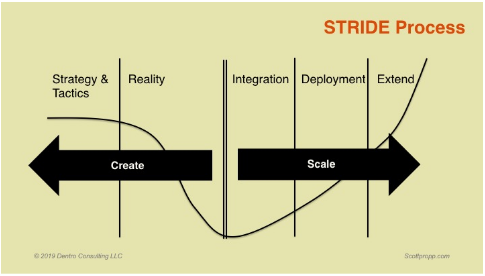The first time I encountered it was as a business development leader charged with traveling globally to win business with cell phone manufacturers. I traveled to more than 20 countries and regardless of the sign on the door, they all had it.
I’d move from the lobby to one of two zones:
- The creation zone was filled with cubicles and monitors. We’d be seated in a quiet conference room. We’d have dark roast coffee, talk details (business roadmaps, calendars measured in quarters and years, etc.), share insights and build relationships.
- The second zone was the ops zone. Many times we’d walk right through the plant, to what was clearly the hand-me-down conference room from the creation zone. We’d have black coffee in a paper cup and talk about quality, units per hour, defects per million units, and costs to the tenth of cents.
These two zones – one governed by the calendar and the other governed by the clock – hold the key to generating value in any business. It was no accident that they were always physically separated, yet as I came to understand, it was how they worked together that would separate the winners from the also-rans. You see, value is designed in the creative zone and captured in the op’s zone. When the two work together, firms win big, and when they are in tension, value gets consumed on internal friction.
I’ve labeled the boundary between the two zones the fault line.
The Pattern of All Patterns
Since this was a boom time, I had the role of developing forecasts – and the devices I was working with them on were in very short supply. My marketing leader suggested that there was data right before our eyes we could use to make better decisions, and she was right on track. We were led to this conclusion because each of our clients was forecasting that they were taking market share from one another – and they couldn’t all be right. We needed something that would allow us to forecast who was most likely to fulfill their internally-developed expectations.
What we learned was the handoff between the two zones was the critical factor in whether a product line was going to make it or land flat.
I’ve used those hard-earned lessons on dozens of projects and shared them with leaders of firms that are of sufficient size to have the divide and realized that they need to conquer it. The number one indicator of having a value trap between the creative zone and ops zone is how well the two groups work together, and a very good measure of that is communications. When I speak to leaders on either side of the fault line, I explore how often they work together, how it gets initiated and what kind of joint measurements they use to guide the work.
Really successful firms have done the work to use the fault line like a trampoline to create breakthrough successes.
Mastering this handoff is a “critical to success” skill for every senior leader.
How do You Know You Have Fault Line Trouble?
The first principle that I share about the zones, is that left to their own devices, they will work independently. One of the reasons that the New Product Process has received so much attention is that these two zones need to be joined via process, or they simply will focus inward without critical insights being co-developed between the two. When they are disconnected, the overall time to market and quality suffer.
So what do the symptoms of this fault line issue look like? As you might suspect, they break out by zone.
Op’s Zone
Overanalysis
- What it is: An ops team insists on using an optimization strategy on every potential issue – trying to move risk to zero.
- Why it creates issues: When doing new product work, it is essential to use a prioritization strategy to find and solve the issues in priority order. This level of analysis causes products to slow to a crawl.
Over and early commitment to execute
- What it is: Many times the ops team will over-commit to execution, expending time and effort on heavy, expensive, and immovable solutions.
- Why it creates issues: This creates huge inertia and makes the new product process overly complex as sunk costs now enter into the mix of production tool decision making.
Experimenting in the production environment
- What it is: When a team uses a larger-than-needed production run as a way to optimize the product. This can also happen when too many beta clients are given early access to a solution.
- Why it creates issues: A close cousin of the above, this creates big issues in efficiently solving problems because, in addition to solving the problem, you are now looking at a path that conserves time, material, and effort used to build the first run. All this while maintaining beta client satisfaction – not easy.
Create Zone
Endless iteration
- What it is: Teams of creators frequently develop options well beyond the original scope of the program.
- Why it creates issues: By not “shipping” the value of the work they’ve done, it doesn’t get to market and the firm doesn’t see a return.
Using intuition over data
- What it is: Visionary and charismatic leaders enjoy rapidly building out ideas and concepts. This leads to valuing intuition to make key decisions.
- Why it creates issues: In their zeal to connect and build new approaches, it is easy to miss areas where data and facts can greatly improve or completely change an outcome.
Mistaking validation testing for execution
- What it is: When working out the fictional elements of a business plan, many times intermediate “mock-ups” of the product are developed.
- Why it creates issues: Physical mockups are incredibly addictive, and once a senior leader falls in love with one, it can preclude the needed interactions that can create a truly breakthrough project.
Why it’s Critical
When each group isolates, it limits the value that it can develop.
Particularly on the Op’s team side, there is only so much progress that can be made incrementally until you need to engage a process that can jump the problem and create orders of magnitude improvement. It’s only by moving these problems to the Creative Zone that this kind of work can be done.
Bridging these two zones allows data and information to flow both ways, and at critical times, better decisions can be made. This elevates the entire process, for example, keeping both teams from locking in a suboptimal solution based on its own context. By elevating the needs of the client and the value created, both teams are freed up to provide the best joint solution.
One example of this is a cost reduction program that was badly underperforming, with the ops team who was accountable for the project being completely stuck. We brought the creative team in for a joint session and provided the needed physical models of the B2B product so that quality dialogue could take place. Over the course of a 3-day workshop they developed dozens of fresh ideas.
Joining the Two Zones
I have built and utilized a framework and methodology that allows the two zones to work together to create the best possible solution for the firm. I use the acronym STRIDE to describe the joining of these two zones, in which we break each side into three phases with specific entry and exit criteria which create a “couplet” of cooperation between the two groups.
Without a formal action to create synergy between the ops and creative zones, the natural forces of organizational siloing and isolation will prevail. This invisible force field creates rigidity and fragility when a firm meets unexpected competition or disruption.
This method combined with best practices in selecting cross-functional team members unlocks firms from getting stuck in either the Ops or Creative zones. For more information on STRIDE, you can look at the articles here, here, and here.
If you would like to talk about establishing a high functioning team that crosses this boundary, please email me or use this link to set up a time for a short discussion.
Related posts you can benefit from…



